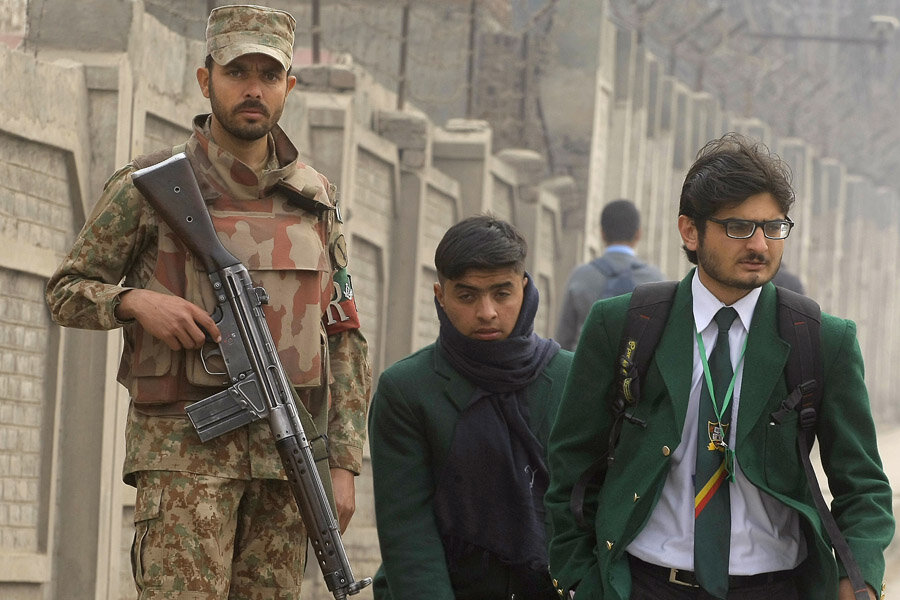Pakistani school reopens after Taliban massacre
Loading...
| Peshawar, Pakistan
Pakistani children returned on Monday to the school where Taliban gunmen killed 150 of their classmates and teachers last month, clutching their parents' hands tightly in a poignant symbol of perseverance despite the horrors they had endured.
It was the first time the school had reopened since the assault and security was tight. The nation has been reeling from the Dec. 16 terrorist attack in Peshawar — one of the worst Pakistan has experienced. The violence carried out by seven Taliban militants heaped pressure on authorities to end the stubborn insurgency that kills and maims thousands every year.
The massacre also horrified parents across the nation and prompted officials to implement tighter security at schools.
For Peshawar parents like Abid Ali Shah, Monday morning was especially painful as he struggled to get his sons ready for school, something his wife used to do. She was a teacher at the school and was killed in the violence. Both of his sons attended the school. The youngest was shot in the head but survived after the militants thought he was dead.
"A hollowness in my life is getting greater. I am missing my wife," Shah said. He said he had wanted to shift his children to a different school or city but decided not to because they still have to take exams this spring: "Everything is ruined here, everything."
His older son, Sitwat Ali Shah, 17, said that when he saw his brother break down in tears as they prepared to go to school he did as well. Sitwat said both he and his brother have trouble sleeping and often wake up, crying for their mother.
"Those who have done all this to all of us cannot be called humans," Sitwat said, adding that he still wanted to go back to school and eventually become an air force officer.
A ceremony was held at the school to mark its reopening, and classes are to resume on Tuesday. Security was tight, part of a countrywide effort to boost safety measures at schools in the wake of the attack. Schools around Pakistan have raised their boundary walls, added armed guards and installed metal detectors, although many have questioned why it took such a horrible attack to focus attention on school safety.
A psychiatrist in Peshawar, Dr. Iftikhar Hussain, said troubled parents have been calling to ask how they should discuss the attack with their children and how to respond when their kids have questions about the violence: "It's a time of great depression and tension for all parents," he said.
The government has stepped up military operations in the tribal areas, reinstated the death penalty and allowed military courts to try civilians — all attempts to crack down on terrorism. But in an attack on Monday, gunmen killed seven paramilitary soldiers in the southwestern Baluchistan province, underscoring the dangers the country still faces.
In Peshawar, media and vehicles were kept hundreds of yards away from the Army Public School, which had coils of barbed wire freshly installed on top of the compound's walls, and two helicopters circled overhead. The chief of Pakistan's army, Gen. Raheel Sharif, was on hand with his wife to greet and console the students.
Some women brought garlands of flowers and draped them around the children. Passages from the Quran were read and the national anthem was sung while parents, students and teachers were given pamphlets about the psychological impact of terror attacks on children.
On social media, some Pakistanis questioned why top government officials were not at the ceremony.
Teacher Andleeb Aftab, who lost her 10th grade son Huzaifa in the attack, came in a black dress and head scarf, walking to the place where she had last seen her son alive. She said she chose to go back to school rather than sit at home and keep mourning.
"I have come here because the other kids are also my kids," she said. "I will complete the dreams of my son, the dreams I had about my son, by teaching other students."
On Sunday night, 15-year-old Ahmed Nawaz said he is still in constant pain and being treated for his badly wounded left arm but that he was determined to go back.
For the militants, he said he had one message: "We are not scared of you."
But in many families, apprehension mixed with anger. Aurangzeb Khan lost his 16-year-old son in the attack while his other son survived.
"We all are scared after this incident," Khan said. "I am not satisfied about what they are claiming or what they are doing for security and safety of the children."





